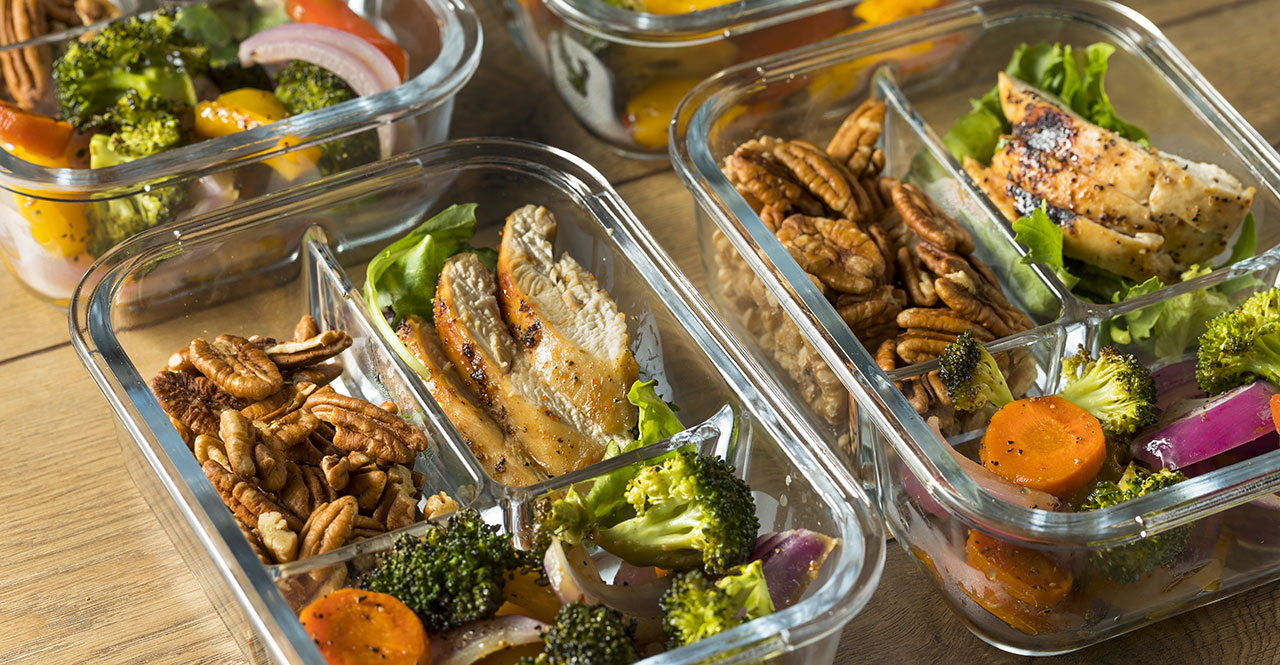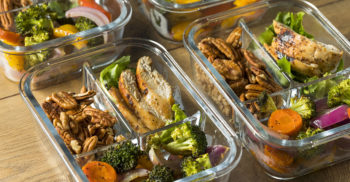 Reading Time: 10 minutes
Reading Time: 10 minutesThere are a lot of people who have decided to go the “keto” diet route these days. A ketogenic diet can help you lose weight, manage hunger, reduce inflammation, and promote an overall healthy system.
“How?” you might ask.
How a ketogenic diet works
In a standard American diet, your body relies on sugar, or glucose, for its fuel. Your primary energy comes from eating carbohydrates. You eat them, your insulin stores them in your muscles and liver, and they’re mobilized when they’re needed for exercise or energy.
Your body, however, can only store about a day’s worth of fuel, leaving you always on the “hunt” for food.
A ketogenic diet relies on stored fat for fuel. By reducing your carbohydrate intake and increasing fat, you can enter a state called ketosis in which your liver oxidizes fatty acids into what are known as ketones (or ketone bodies) that can be used just like glucose for energy in your muscles and brain.
The average person can store at least 30 days of this kind of energy in their body, making it much easier to manage appetite throughout the day using ketones, even when you find yourself hours from a meal.
Now, there are some benefits to glucose and others to ketones, so depending on what your goals are, it’s important to keep them in mind:
- Glucose that is stored in your muscles is much more rapidly accessible for your muscles. That means if you’re lifting heavy weights or sprinting, having your muscle glucose topped off will improve your performance in these areas.
- Ketones produce much more ATP (your body’s energy currency) per cycle than glucose does, making it a more efficient fuel for longer term energy needs
- Your brain, which consumes the majority of your body’s energy, can function on both glucose and ketones.
So how do I get into ketosis?
The short answer here is to follow a ketogenic diet. By definition, a ketogenic diet generates ketones. That means that not just any low carb/high fat diet will do it. The general rules for your macronutrient balance in a ketogenic diet are:
- 75% of your calories from fat
- 20% of your calories from protein
- 5% (or less) of your calories from carbohydrates
In a 2200 calorie diet, that would be equivalent to 185g of fat, 110g of protein, 25 g of carbohydrates
One important thing that is too seldom mentioned when talking about a ketogenic diet is protein. A ketogenic diet is not a high protein diet. It is a moderate protein diet. Some adherents will eat even less protein than this. At the very least, make sure you’re getting at least .8g of protein for every 2 pounds of bodyweight or 1.2-1.7g of protein per kg of bodyweight. Too much protein at any given meal can “knock you out” of ketosis, so be careful.
As you become more conditioned to a ketogenic state, you may find that your body can tolerate higher levels of carbohydrates while remaining in ketosis. Some can eat between 50–100g of carbohydrates each day once they are fat adapted. Until then, however, it is important to keep carbs as low as possible. That means that your only sources should be non-starchy vegetables and some low carb fruits, like berries, papaya, grapes, plums, and apricots.
A couple of other things to remember are to drink plenty of water and avoid snacking between meals. Snacking can reduce ketosis and weight loss. If you must eat, stick to high fat foods like eggs, cheese, avocados, nuts (and nut butters), and olives.
How will I know if I’m in ketosis?
There are currently 3 reliable ways to tell if you’re in ketosis:
- Blood ketone meter: This is the most accurate and reliable way to test, but there are ongoing costs.
- Breath ketone meter: These are newer and can be less accurate, but don’t have the ongoing costs of purchasing testing strips for a blood testing meter.
- Urine ketone strips: These are the cheapest and least specific form of testing, but can let you know when you have entered ketosis. The drawback to strips is that over time your body stops dumping ketones into your urine and the strips can no longer measure the level of ketones in your body.
At the outset, your best bet is using urine strips. They are the least expensive option and if you’re just starting out, it may take you days of over a week to get into ketosis for the first time. The strips will let you know that you’re achieved ketosis, but they are less specific than the meters.
Once you know you’re in ketosis, a blood or breath meter is a good option. Blood testing strips can run from $1–3 a piece, so they’re not typically something you’ll want to use in the period when you know you are not going to be in ketosis yet.
What can I eat?
A typical ketogenic diet relies on whole foods like: meat, seafood, butter, olive oil, avocados, nuts and seeds, leafy greens, and cruciferous vegetables like cauliflower and broccoli.
Foods you should avoid on a ketogenic diet are: bread, pasta, rice, and other grains and refined grain products, beans and legumes, high carbohydrate fruits and vegetables, beer, soda, juice, and all forms of added sugar.
What are the benefits of a ketogenic diet?
Weight loss
As your body “burns” stored fat for energy, you’ll naturally shed the pounds those fat stores add.
You may wonder where all that fat you’re eating goes. When you don’t eat fat in combination with carbohydrates, it is prone to be burned as energy. In combination with your basal metabolic rate (the energy you need each day just being alive), daily activity energy needs will exceed the energy the fat you eat can provide.
What’s more, certain fats, like MCT (medium chain triglycerides) from coconut oil are not able to be stored as fat. Supplementing your fat intake with MCT (like in your morning coffee) oil can provide energy without adding a source of fat that can be stored.
Appetite control
When you’re on a ketogenic diet, you’re relying in a type of fuel that your body has ready access to, day and night. Reducing carbohydrates and eating protein also improve your sensitivity to leptin, the hormone that tells your body you are full.
In addition, the “hunger” hormone called ghrelin may be suppressed by the presence of ketones in your blood. The mechanism isn’t perfectly understood, but you’ll benefit from the correlation in a decrease in hunger throughout the day.
Increased energy
Because fat supplies and ketones can provide a steady stream of energy (compared to the ups and downs of sugar consumption, storage, and release), you can experience greater energy throughout the day on a ketogenic diet than on a typical high carb diet.
This can also contribute to greater physical and cardiovascular endurance. Having access to high energy fat throughout a long workout can give you more consistent energy than the limited amount of sugar you can store.
Many people who eat a ketogenic diet also report greater mental clarity through the day. Your brain doesn’t need glucose and can thrive exclusively on ketones. For the same reasons you can experience consistent physical energy on a ketogenic diet, you can maintain mental energy and focus with a steady stream of ketone bodies, without the fluctuations that come with relying on glucose.
Improved health
There are any studies that show that low-carb diets improve risk factors for heart disease, like your cholesterol profile. It’s also normal among ketogenic dieters to see improved blood sugar levels, insulin levels, and blood pressure.
The scientific evidence that indicates that the keto diet can help reduce your risk of heart disease includes the lowering of high blood pressure and minimizing triglyceride levels.
Is a ketogenic diet for me?
First, who should not do a ketogenic diet (or should talk to a doctor first):
- Insulin dependent diabetics: High ketone levels in combination with high blood sugar and dehydration can lead to ketoacidosis, a condition of uncontrolled ketone production that can lead to nausea and vomiting, abdominal pain, shortness of breath, confusion, and can even be fatal.
- People on blood pressure medication: A low carb diet can reduce your blood pressure significantly. This may happen quickly or over time. In combination with blood pressure lowering medication, you may put yourself at greater risk. Consult with your doctor before trying a ketogenic diet.
- Breastfeeding mothers: Breastfeeding requires more calories in general, but for reasons not yet understood, the ketogenic diet while breastfeeding can trigger a condition known as ketoacidosis. The most important thing while breastfeeding—for mother and baby—is calories. While it’s possible to eat a ketogenic diet while breastfeeding, the risks may not be worth the reward.
If you’d like to experience the benefits of a ketogenic diet and are willing to put up with a few side effects and restrictions, trying it out is for you!
There can be some discomfort when starting a ketogenic diet. The most common side effect is known as “the keto flu.”
The keto flu involves symptoms like headache, fatigue, brain fog, nausea, irritability, a lack of motivation. These result from your body’s failure to locate the glucose it needs for fuel at the outset of the diet. Your body turns to the fuel it knows best and when it can’t be found, your brain and body will feel the effects.
As you cut carbs out of your diet, you will also lose excess water that is retained in a carbohydrate rich diet. This will also cause you to lose salt. This loss, combined with the loss of your body’s preferred fuel source, are what are behind the “flu.” Incidentally, much of the initial rapid weight loss you see when undertaking a ketogenic diet is the water that is lost.
As you adapt to burning fuel, these symptoms will go away. But for some this can take 1–2 weeks.
In addition to this it’s important to remember that the ketogenic diet, while not necessarily extreme, is different from what is commonly seen in today’s world. That means that it is not as supported in places like restaurants and social get-togethers as a standard American diet.
There may be times when in order to “stay keto” you may have to go hungry or feel like the weirdo who orders off of a menu like Sally in When Harry Met Sally. It’s important to remember that any diet requires preparation on your part to stay fed. You’ll need to be ready to take responsibility for making sure you know ahead of time what you need for yourself.
How to get started with a keto diet
Some find the transition to a ketogenic diet easier if they slowly reduce carbs and replace those calories with sources of healthy fat over a period of a week or two, until they reach the desired ratio for ketogenesis.
This strategy can work well for some, but for others, a cold turkey approach is the best way to say goodbye to their old way of eating.
Either way, there are steps to take to get yourself (and your kitchen) ready for a ketogenic diet:
- Get rid of anything that is not allowed—bread, pasta, cookies, crackers, soda, etc.
- Stock up on keto “friendly” foods—meats, eggs, cold cuts, nuts, butter, olives, coconut oil, canned tuna, etc.
How to get extra fat on a ketogenic diet
Eat full-fat ingredients. When choosing dairy like yogurt, milk, or cheese, buy the full fat options.
Cook with fat. Butter and oil are your friends on a ketogenic diet. Use them liberally.
Fat as flavor. Enrich your finished dishes with butter or drizzles of olive or other healthy oils
Garnish with fat. Adding nuts or avocados to salads are an appetizing way to get more fat into normally low fat dishes
Snack on fat. Snacks like cheese, nuts, and hard boiled eggs are natural go-tos on a ketogenic diet.
Add fat to your coffee. Blend butter, coconut oil, and MCT oil into your morning coffee. It may sound strange, but butter tea is an age old tradition among the sherpas in the Himalayas. Too weird? You can also use heavy whipping cream.
Fat bombs. There are lots of recipes out there for building keto fat bombs for dessert, but a simple way to start is with berries and heavy cream.
- Pick a low-stress week to get started. There are going to be some pains involved in getting going. You’ll want to make sure you’re not adding to an already stressful situation.
- Commit to getting good sleep and exercise in addition to your diet. A healthy diet is only one part of a healthy lifestyle. Picking a sensible bedtime and getting exercise each day will work in synergy with your diet to support your goals and your commitment
Wrapping up
Starting a ketogenic diet is a great way to kick off a health and wellness journey. Not only can it reduce weight, it can improve health markers, stave off disease, and give you more energy than you’re experiencing today.
One important thing to remember is that nothing is permanent. You may find that the ketogenic diet works for you for a while but that after some time, you’d like to incorporate more (healthy) carbohydrates into your diet. That’s fine. Many people cycle on and off a ketogenic diet over time.
There is more to a healthy life than diet, though. Make sure that you’re not relying solely on your diet to meet your healthy lifestyle needs. Exercise, sunshine, good sleep, managing stress, and spending time with friends are all important parts to pay attention to. Don’t sacrifice balance in striving for a “perfect” diet.
The ketogenic diet may feel like a restriction at first. Over time you will become accustomed to it and its rules will become second nature to you. If you can overcome the initial obstacles, it can make you look and feel great as well as contribute to a long life of health and well-being.







